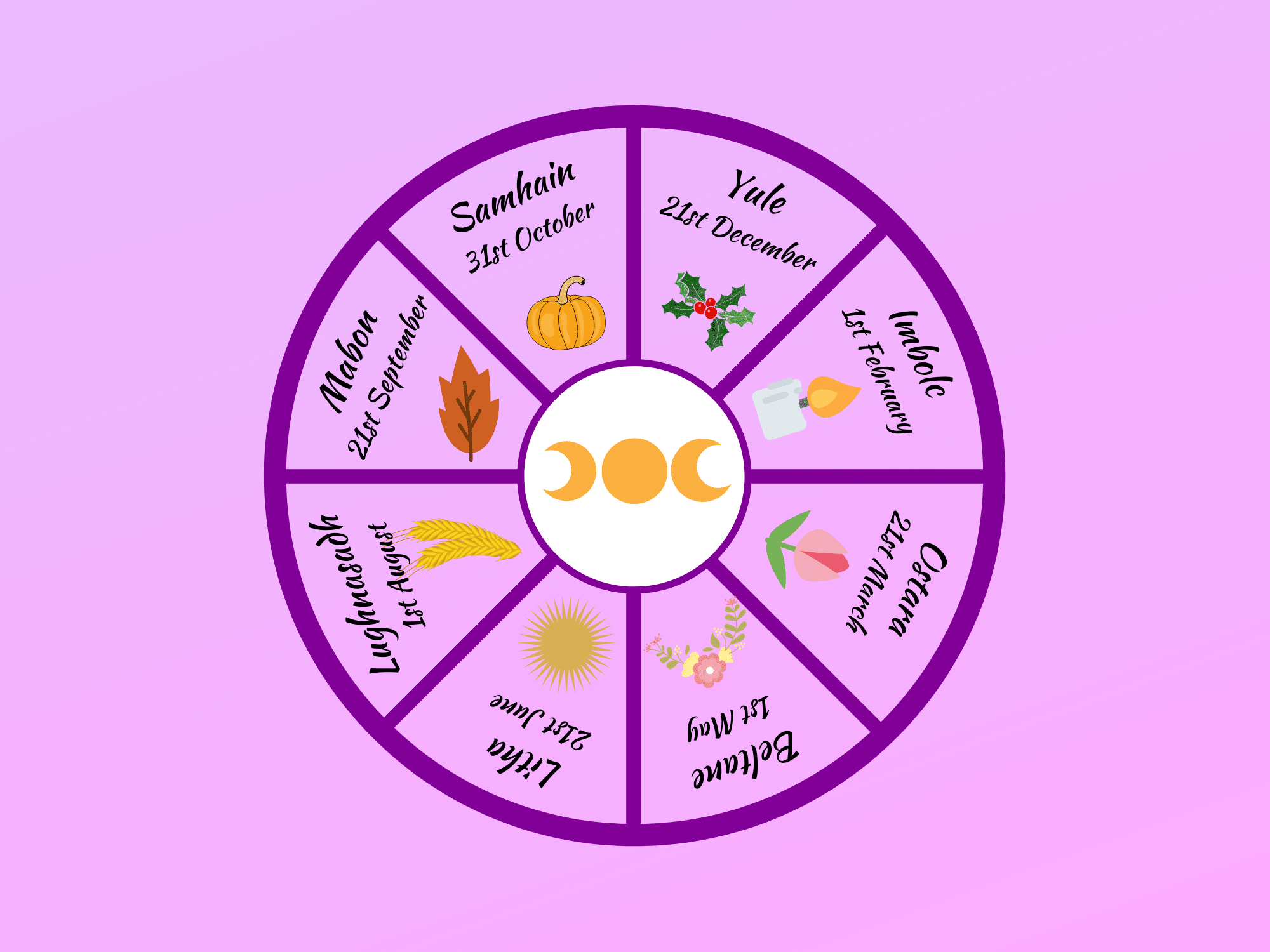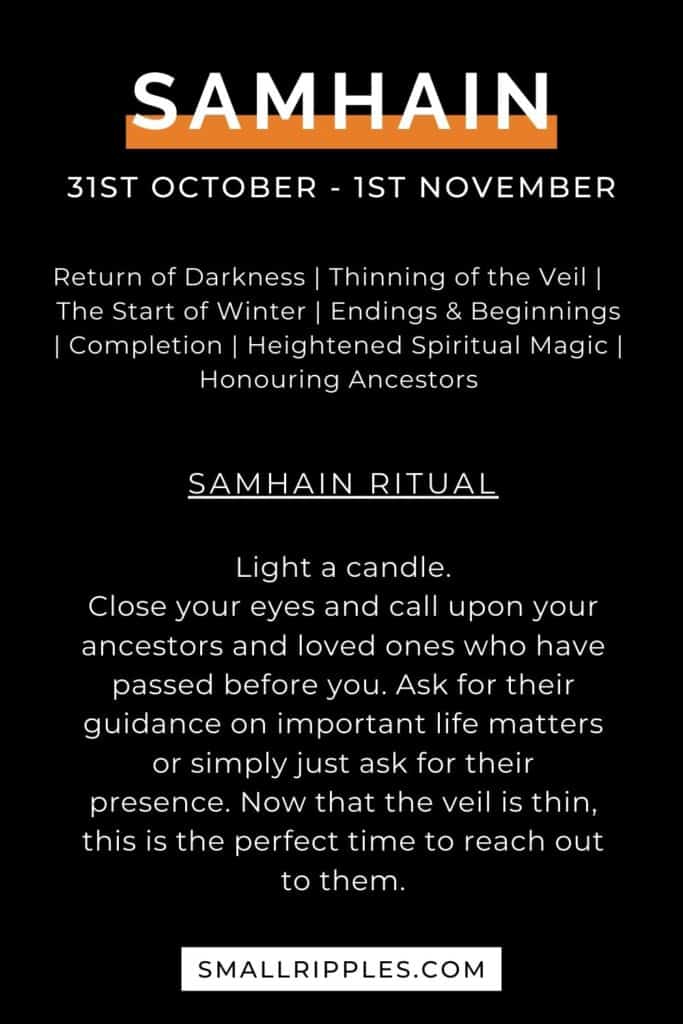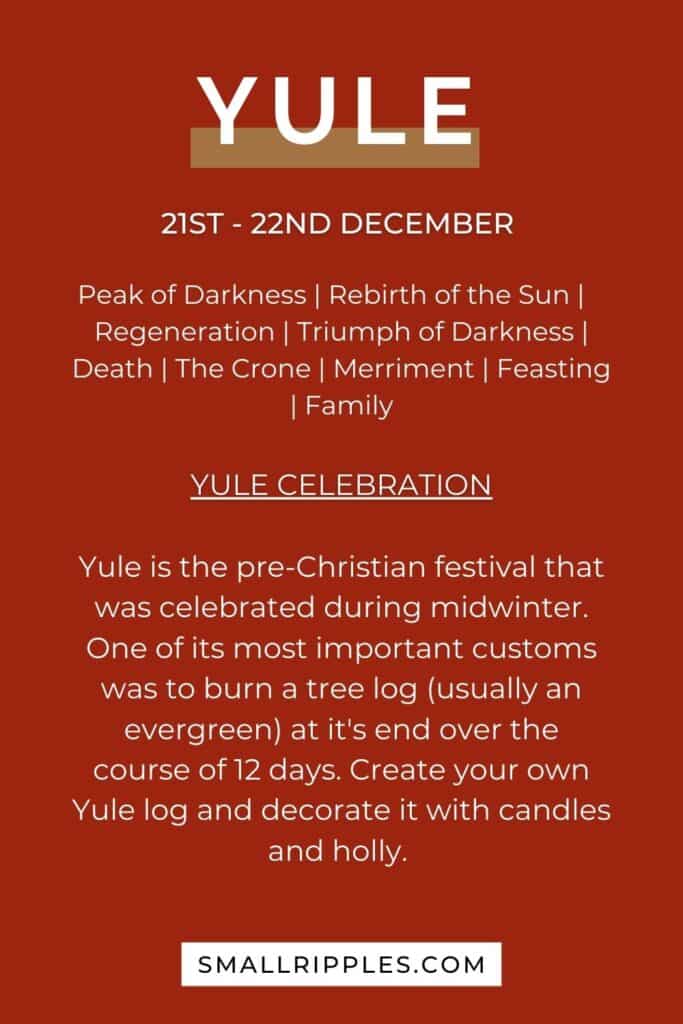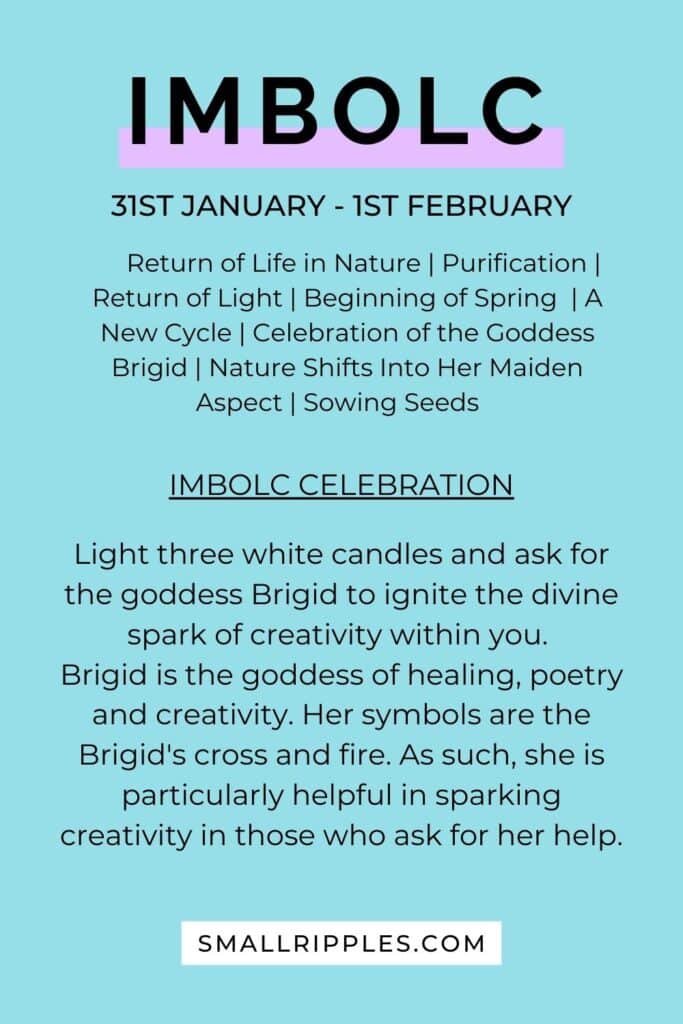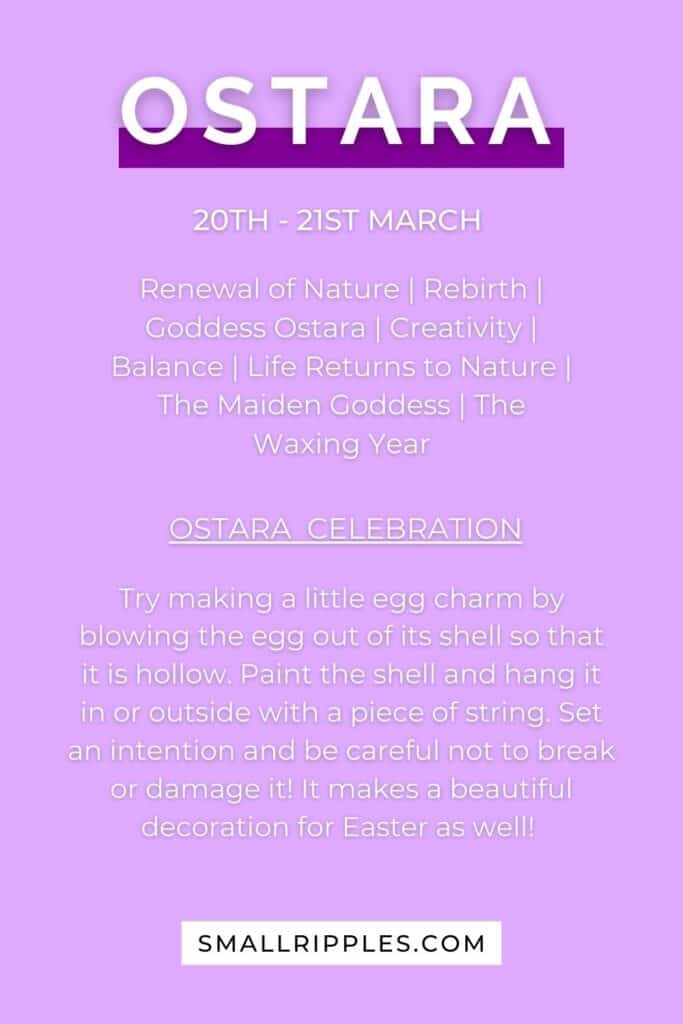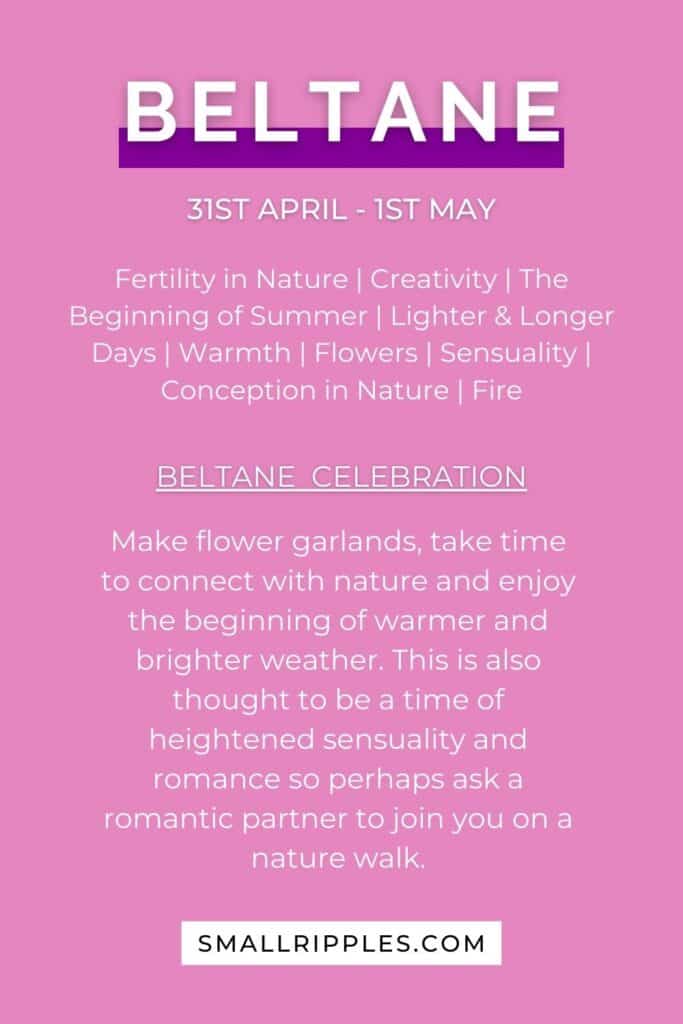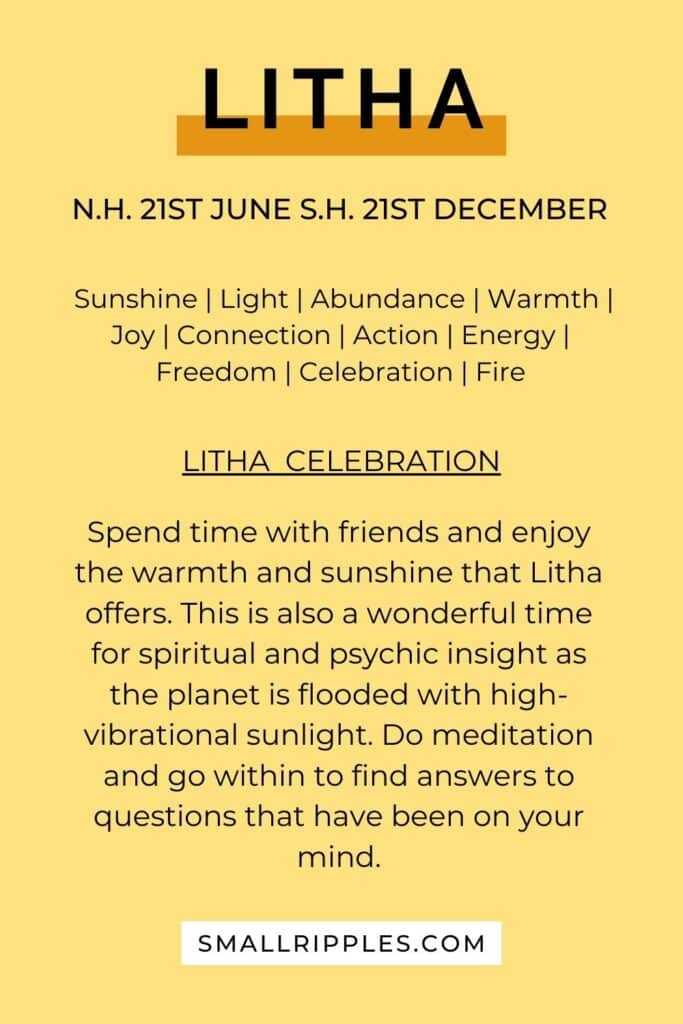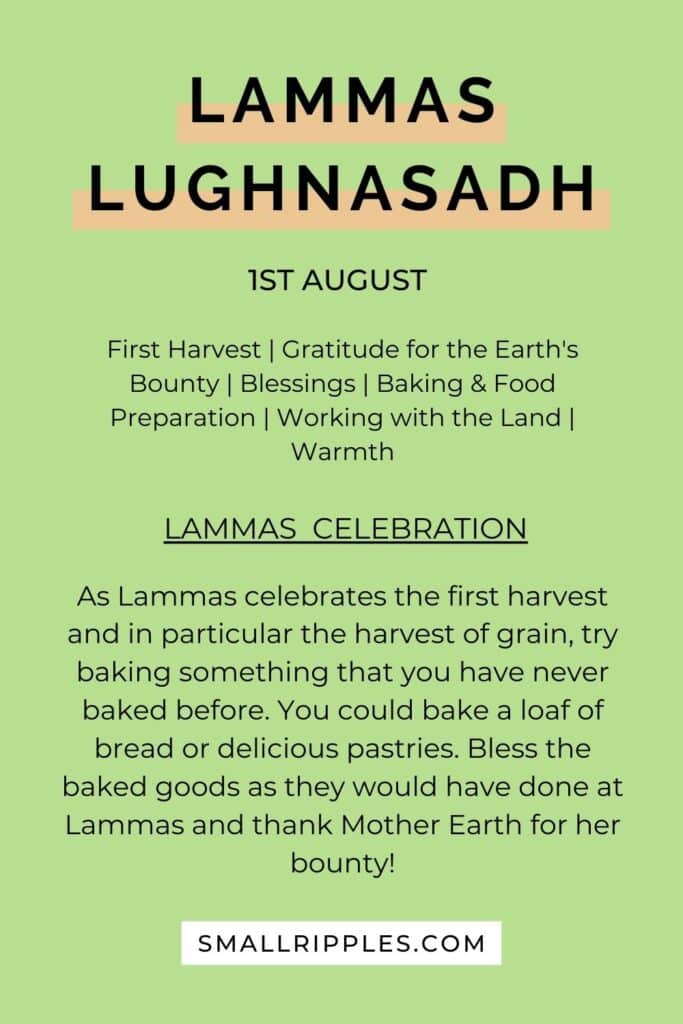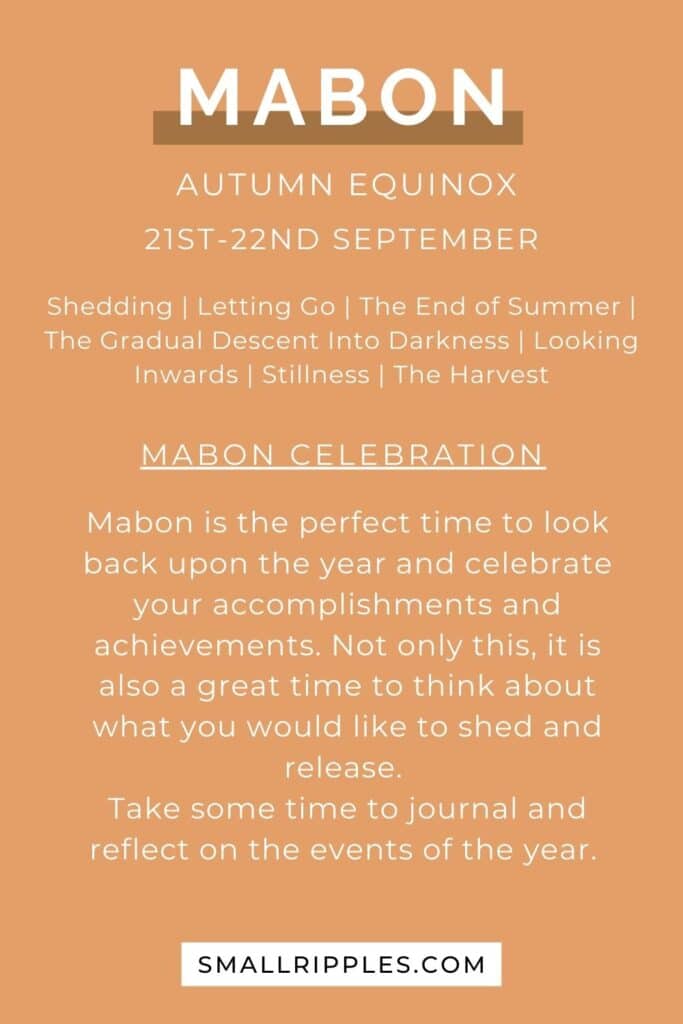To some, as soon as they think of the wheel of the year, they imagine dark pagan rituals on summer solstices along with black magic and other things that go bump in the night.
And yes it is true that the official Wheel of the Year calendar and its dates were settled by those in the Wiccan and Neopagan movement whose witchy inclinations might make some feel uneasy.
However, I believe that if we put our reservations to one side and take a look at what the Wheel of the Year really is about, we would see that with it is the pattern of Divine Creation.
Contents
What is the Wheel of the Year really about?
So to put it simply, the Wheel of the Year refers to the eight sabbats or points of the year (solstices, equinoxes and cross-quarter days) that make up the pagan calendar. Each of these points, mark a shift and change in nature which is thought to hold magical and spiritual power.
Many of the ways these points of the Wheel of the Year are celebrated today are modelled on much older pre-Christian traditions and celebrations. In fact, many of the traditions of festivals such as Samhain (Halloween), Yule (Christmas) and Beltane (May Day), have been passed down over the years and evolved and altered as time has passed.
Why Were the Points of the Wheel of the Year Important to Our Ancestors?
Before we get into the nitty gritty details of how the Wheel of the Year is formed, I would like to paint you a picture so you can understand why the dates of this incredible cyclical calendar were so significant to our ancestors…
For many of us living in this technologically advanced modern era, it is quite difficult to understand how people lived a millennia ago but to them, nature would have been everything.
Their very survival rested upon their knowledge of the changes in nature and the agricultural year. For without this knowledge, they would not have been able to grow food and have bountiful harvests.
This is exactly why these seasonal changes were so important to them, as was the variance in hours of sunlight they would have during the day.
In this modern age, we are so used to electric lighting that when the days begin to grow darker, it is quite easy for us to just switch on the light. But can we imagine what it was like to live with a blanket of darkness stretched across the sky for most of the day with only candles and fire to provide illumination?
Can we also imagine the joy and excitement when those really frosty months were coming to a close and the days began to get lighter and warmer? I wonder how they must have felt when they started to see the first spring flowers or were able to harvest the first crops.
Boy, do we have it easy in this day and age!
Why Is It Worth Learning About The Wheel of Year?
For us, it is very easy to ignore nature. In many ways, the seasons do not affect our lives a great deal other than how many layers we should wear.
But I believe it is so important for all of us to understand the Wheel of the Year, whether we have any spiritual leanings or not.
This is because when we learn about the changes of nature and start to pay attention to them, we begin to appreciate the natural world so much more!
We are not separate to nature, we are apart of it. Unfortunately, in this modern era where our lives are ruled by technology, it is easy to live in a way that is disconnected from nature but is it healthy and is it natural for humans to live so separately from their original habitat? I don’t think it is and for me it so much more spiritually fulfilling to be attuned to nature and honour its cycles.
This is why I have created this Wheel of the Year Bundle to help you stay aligned and attuned to the cycles of nature. It contains correspondence pages with key information, card spreads to celebrate the various festivals as well as celebration planners to help you plan out rituals for the sabbats.
Get the Wheel of the Year Bundle – 15% off with code BLOG15
Get the Wheel of the Year Bundle Here
How the Wheel of the Year Has Helped Me
For about the past two years, I have come to learn about the different ancient festivals that celebrated the different points of the agricultural and solar calendar.
As I came to learn more about it, I realised that the Wheel of The Year was so much more than just seasonal changes. The changes that nature goes through as well as her cycles, are an archetypal pattern that the Universe likes to repeat. It follows the pattern of Birth, Death and Rebirth that much like a wheel, is never ending.
We can see this pattern in the cycles of the moon, in our stories (think the heroes journey), the female menstrual cycle and even in our spiritual journey through life.
Much like the moon, the seasons wane and they wax, they expand and contract, like breathing inwards and breathing outwards.
I even realised that the challenges and different periods we experience in life work much like the seasons (you can read about the different seasons of life here).
When we come to learn this sacred pattern of birth, death and rebirth that the Wheel of Year centres around, we come to understand how this pattern is integral to all life.
Let’s Get Started!
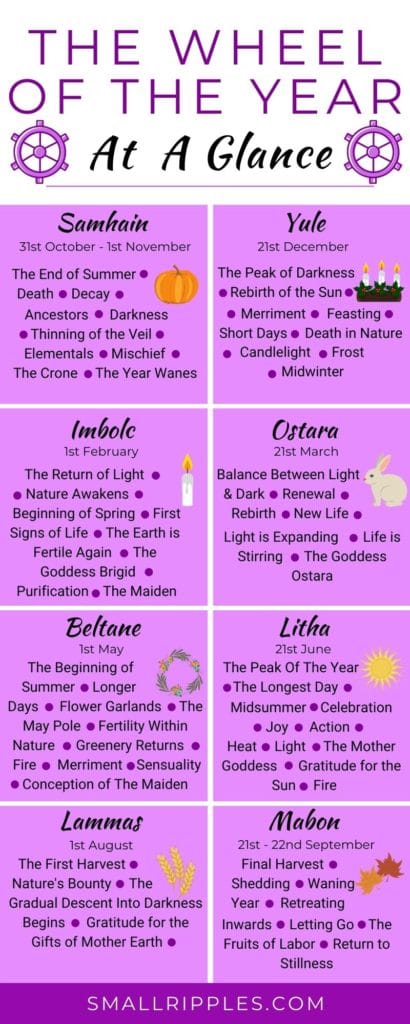
The Wheel of the Year: The Eight Sabbats
Samhain/Halloween (cross-quarter day)
Northern Hemisphere: 31st October – 1st November
Southern Hemisphere: 1st May
Samhain is where the wheel of the year begins. It is the point of the year where we say goodbye to the warmer and lighter days of summer and welcome the onset of darkness as the light begins to shrink.
Nature is drifting into a sleepy slumber and will only again awake when we arrive at Imbolc.
Spiritually, it is a time where we look within ourselves. The distractions and busyness of summer has come to an end and now is the time to do our inner work. If the energy of summer lures us out of our cocoon, Samhain invites us to retreat back into it.
Traditionally, Samhain was a Gaelic and Celtic fire festival where preparations would be made to ensure that communities had all they needed to survive the cold and harsh months ahead.
Animals were led down from the summer pastures and the weaker ones were slaughtered so that food resources could be spared.
It was also a time of superstition where the veil was thought it be its thinnest.
During Samhain, it was believed that fairies would come out of the Otherworld beyond the veil and wreak havoc and mischief.
Samhain eventually evolved into All Hallows Eve (a catholic holiday of remembering the dead) and then eventually the modern celebration of Halloween. You can read about its history and evolution in my blog post The True Origins of Halloween and Its Spiritual Significance.
Samhain Correspondences:
Nature: Squashes, Gourds, Pine Cones, Mushrooms & Fungi
Symbols: Pumpkins, Skeletons, The Crone, Elementals & Ancestors
Colours: Orange, Black and Red
Yule/Winter Solstice –
Northern Hemisphere: 21st December
Southern Hemisphere: 21st June
When we arrive at the Winter Solstice (also known as Yule), we find ourselves at the darkest point of the Wheel. The hours of sunlight have shrunken only to a mere few hours with the rest of the day being shrouded in darkness.
The days are cold and harsh and it feels like winter will never end. Yet, there is hope…
The darkness finally begins to abait and the shortening of the days finally ends. The sun has been rebirthed and will only get stronger as the days pass by.
And we have gone through a transformation as well. Like the darkness of a mother’s womb or a caterpillar’s cocoon, life springs forth.
The winter solstice reminds us that for life to exist there must be darkness first. It is in the void of all that is, that life begins.
The ancients knew that this was a particularly special time of year and as such there were many different celebrations of midwinter that existed all over Europe.
For example, during midwinter, the Romans held the festival Saturnalia (one of their most important festivals) every year on the 17th December. It was a celebration of the god Saturn who was the god of agriculture, renewal, liberation and wealth.
There was feasting, an easing of moral restrictions, gift-giving and even sacrifices made to the god Saturn.
In northern Europe, a very different festival took place which went by the name of Jol/Jul and later became known as Yule or Yuletide.
This festival celebrated the peak of winter and much merry-making and feasting took place during this festival. The most well-known tradition that has survived was the Yule Log that would be brought in and burnt at its end. Each night for 12 days the log would be burnt and if there was any remaining it would be kept for the following year.
The festival of Yule/Jul eventually came to Anglo-Saxon England as Scandinavian northern invaders reached its shores and the celebration of Yuletide and Christmas became one.
In modern times, the celebration of Winter Solstice for Wiccans and Pagans centres around the Celtic legend of the battle of the Oak and Holly King. The Oak King defeats the Holly King as light is restored to Earth.
For more ways to celebrate Yule check out this great blog post on Wayward Inspiration.
Yule Correspondences
Nature: Holly, Evergreen Trees & Pine trees
Symbols: Yule Log, Christmas Tree & The Hearth
Colours: Red, Green, Gold, Silver, Black
Imbolc (cross-quarter day)
Northern Hemisphere: 31st January – 1st February
Southern Hemisphere: 1st August
Finally after the dark and cold of Winter, we find ourselves at Imbolc – the beginning of spring and the end of winter. Imbolc is a time of purification and renewal. In fact, the very name of Imbolc (pronounced ‘Im-ulk’) means exactly that.
Snowdrops begin to appear from the cold hard ground which is the first sign that there is life again in nature.
The hours of sunlight start to slowly lengthen and now the land can be prepared for the new agricultural cycle.
The celebration of Imbolc originates from Gaelic Ireland where celebrations would be held to honour the coming of Spring.
Imbolc is often incorrectly said to mean ‘in the belly’ when it is actually based on an older word for milking and purification. This is because during this time, the ewes would begin to lactate and their milk would have been the first fresh food that the ancient gaels consumed.
And Imbolc would not be complete without mentioning the beautiful goddess Brigid. On this day Brigid blesses the land, restoring its fertility and rejuvenating it.
Brigid is the goddess of smithcraft, creativity, healing, poetry, fire and even battle. She eventually was remodelled as a saint after the Christianisation of Ireland and Imbolc later became known as St Brigid’s day.
A Brigid’s cross (woven rushes in the form of a cross with bent edges) was hung in homes for protection and luck and eventually came to be the symbol of this day.
If you want to read more about Imbolc and Brigid, I suggest reading my post here.
Imbolc remains an important point of the Wheel of the Year, it is the moment the tide turns and we are truly on track to welcoming the light back into our lives.
Use this time to start a new cycle of your life. Sow seeds of intention and start new projects.
Read more about Imbolc in my blog post What is Imbolc?: The Goddess Brigid, Rituals and the Return of Light
Imbolc Correspondences
Nature: Snowdrops, Daffodils,
Symbols: Brigid’s cross, Brigid ‘Biddy’ doll
Colours: White, Yellow, Light blue
Ostara/Spring Equinox
Northern Hemisphere: 21st March
Southern Hemisphere: 21st September
The Spring Equinox is a time where both night and day are of equal length. The dark has given way to the light, and the light now reigns supreme.
Nature has moved into a state of balance for now.
However, most importantly nature has been reborn and the rebirth of nature is to be seen everywhere! Even under the cold ground, life is stirring as tulips begin to sprout and the trees become shrouded in blossom. The Earth has come back to life!
Not just this, but the cold and dark of winter has finally been lifted and there is a feeling of hope in the air.
The theme rebirth is also carried out in another very well known celebration…
Not long, after the Spring Equinox has passed comes the celebration of Easter and the two definitely seem to be interlinked in various ways.
Let’s explore further. The 8th century Anglo-Saxon monk Bede whose writings have formed most of what we understand about pre-christian and Anglo Saxon history, writes of a festival called Eosturmonap, the celebration of the goddess Eostre. This festival was celebrated by the pagan Anglo Saxons before their conversion to Christianity.
Eostre or Ostara (as she is also known), was a Germanic spring-time and dawn goddess who was celebrated at the time of Spring Equinox. She represents life, rebirth, and light. Her symbols are eggs and hares.
The customs of the celebration of this spring-time goddess eventually became linked with the Christian celebration of Easter (Pascha) which is why we have our modern traditions such as the Easter Bunny and Easter Egg hunts .
Ostara Correspondences
Nature: Tulips, Daffodils, Crocuses
Symbols: Rabbits/Hares, Ducklings, Eggs, The Maiden Goddess
Colours: Pastel shades of yellow, pink, purple, green and blue.
Beltane (cross-quarter day)
Northern Hemisphere: 1st May
Southern Hemisphere: 1st November
Beltane celebrates the beginning of summer and the end of the dark part of the year. The year is finally beginning to wax as the light expands and the days begin to lengthen. There is a distinct and new warmth in the air during this time, yet, the cool breeze of spring can still be felt.
At Beltane, nature proudly displays her growing abundance as greenery begins to shroud the trees again and flowers start to bloom. Nature is fertile and the conception between the maiden and the Green Man takes place.
The promise of summer is truly felt at the beginning of May and this time would have been full of merriment hundreds of years ago.
The festival of Beltane, like Samhain and Imbolc, is an ancient Gaelic festival that welcomed the warmer and longer days of summer.
The festival centres around fire which is used in different ways to celebrate this time of year. The fires lit at Beltane were believed to have had protective and cleansing powers. As such, two fires were lit which cattle were made to walk through as they were brought up to the summer pastures.
The festival of Beltane gradually evolved to become May Day or in medieval times was known as ‘the May’. The celebration of which was known as ‘Maying’.
Traditions such as crowning the May Queen and decorating the May pole also became common customs. If you would like to read more in detail about Beltane you can read my blog post The Origins of Beltane: Welcoming the Return of Summer.
Beltane Correspondences
Nature: Hawthorn, Rowan, Wisteria, Blue Bells
Symbols: Flower garlands, the May Pole, the maiden, green man
Colours: Lilac, pastel pink, green
Litha/Summer Solstice
Northern Hemisphere: 20th-21st June
Southern Hemisphere: 21st Decemeber
At Litha, we have reached the peak of the Wheel of the Year where the days are at their longest and the sun is at its strongest.
The celebration of Litha is all about honouring the sun and how it nurtures life on Earth. The sun is our giver of life and offers us energy, warmth and light. It is because of the sun that we have life on our planet.
The Summer Solstice is one of the most important celebrations in the Wheel of the Year as it is has been so widely celebrated around the Earth.
In ancient Rome, the summer solstice was celebrated with the festival Vestalia which honoured the goddess Vesta – the goddess of home and hearth.
In Britain, the monolithic structure Stonehenge gives evidence that the Summer Solstice was celebrated in ancient times as this structure aligns perfectly with the sunrise on the solstice.
In Europe, a very old custom that is speculated to have originated in France, was practised on this day. A person would light a wheel of straw and roll it down the hill to see if it would stay alight when reached the ground.
If you would like to read more about Litha, then check out my blog post: The History of Litha
Litha Correspondences
Nature: Flowers, Roses, Lavender, Elderflower.
Symbols: The Sun, Fire, Sea Shells, The Full Moon, Fresh Cut Flowers.
Colours: Yellow, Gold, Orange, Turquoise, Shocking Pink.
Lammas/Lughnasadh (cross-quarter day)
Northern Hemisphere: 1st August
Southern Hemisphere: 1st February
At Lammas the fruit is ripening, the crops are growing and we are now ready to harvest the first of the grain (wheat, oats etc).
Mother Earth is proudly displaying her abundance and the time of ‘plenty’ has arrived.
Summer is gradually coming to an end, although the days remain hot and sunny. Lammas is the fond farewell to the lighter half of the year and the moment we begin to think about preparing for our slow descent into darkness.
Historically, there are two main festivals that celebrate this time of year and both of them focus on the harvest of grain.
The first is the Gaelic festival of Lughnasadh and the second is the English celebration of Lammas.
Lughnasadh was the celebration of the start of the harvest season. The name is derived from the god Lugh who was considered a warrior, King and master craftsman. This god is also associated with truth and oath-making.
Lammas, on the other hand, is Christian in origin, although also celebrates the beginning of the harvest.
In fact, the name Lammas actually meant ‘loaf-mass’ as it centred around a Christian ceremony. Bread would be made with the first of the harvested wheat and blessed.
The bread would also be split into four pieces and put into four different corners of the barn as a symbol of good luck for a hearty harvest.
But there were also games that were played. One game involved letting a sheep loose in the fields to see who could catch it. Whoever caught it, would keep it for good.
This is the time to be grateful for the bounty that the Earth produces and the nourishment and sustenance that it offers us.
Lammas Correspondences
Nature: Wheat & Corn, Apples, Harvested Vegetables, Roses
Symbols: An Ear of Corn, Corn Dolly, The Sycthe, Bread
Colours: Golden Yellow, Light Brown, Dark Pink, Green
Mabon/Autumn Equinox
Northern Hemisphere: 21st September
Southern Hemisphere: 21st March
Mabon is the time of the second harvest. It is a point of equilibrium where night and day are of equal length and we have balance again within the wheel of the year.
Yet, it’s symbol is the waning half moon which means that the light of summer is shrinking and soon we will find ourselves in a harsh dark and cold winter. However, if we are lucky enough, we are sometimes blessed with a few last days of warm summer sun.
The name Mabon, is a more recent term that has been given to the time of Autumn equinox as unlike many other points of the wheel of the year, there is little evidence to suggest that this time was widely celebrated.
However, it still remains an important time in the agricultural year.
At this time, the metaphorical sun is beginning to set in the wheel of the year and now is the time to look forward to colder and darker days.
This change in our lives is something we cannot escape. The leaves are starting to fall and there is a noticeable chill in the air.
It is a time where we reap what we have sown and can look on our accomplishments with pride. But also nature is shedding what it no longer needs, what can we shed at this time?
Mabon Correspondences
Nature: Golden leaves, acorns, pine cones, conkers, seeds
Symbols: Harvested vegetables, Leaves, The Scythe
Colours: Red, Orange, Brown, Golden Yellow
How To Use The Wheel of the Year In Your Own Life
Now that you know a little bit more about the Wheel of the Year, it might be a good idea to reflect on how you can use the wisdom of it in your own life. Perhaps you will pay more attention to the seasonal changes and think about what they represent on a greater spiritual level. Or maybe you will think about celebrating festivals such as Yule, Imbolc or Beltane.
However you choose to celebrate the Wheel of the Year, remember that it represents a fundamental aspect of life which is that it evolves, grows and sinks back into the Earth only to be reborn again. Life is a cycle and we each need to find our own unique way of flowing with this cycle.
(299)

